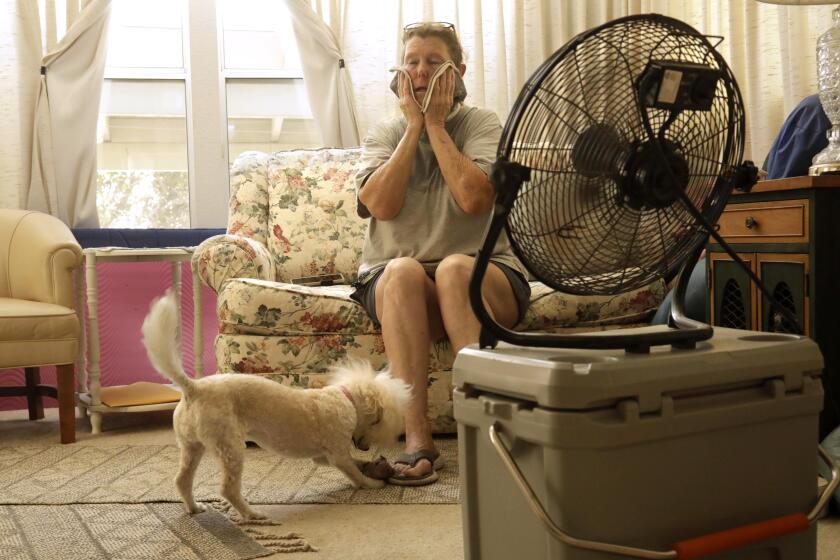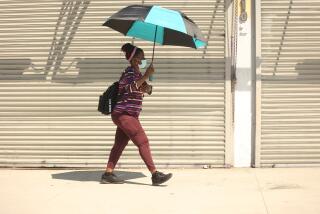Op-Ed: We can prevent heat waves from killing thousands every year

- Share via
Although nearly all heat-related deaths are preventable, heat waves kill thousands of people worldwide every year. At this moment, an extreme heat wave in India and Pakistan, affecting about 1 billion people, is “testing the limits of human survivability,” warns Chandni Singh, a lead author of the Intergovernmental Panel on Climate Change’s Sixth Assessment Report. In April, the average maximum temperature for northwestern and central India was the highest in 122 years.
In recent years, similarly extreme conditions have occurred in the United States, Australia, Europe, Scandinavia and Japan, resulting in thousands of hospitalizations and deaths. Extreme heat is also linked to increases in premature births, low birth-weight babies, and stillbirths; reductions in worker productivity; higher rates of chronic kidney disease of unknown origin; and increases in suicide.
Extreme temperatures are thus an “all of society” problem. Such conditions not only harm human health, they also have detrimental effects on infrastructure, crop yields and poultry mortality, threatening livelihoods and undermining food security. The 2021 heat dome in the Pacific Northwest and western Canada was a case in point.
A bill in the California Legislature would save lives during extreme heat waves by requiring dwelling units to maintain adequate cooling.
It was an event that would have been virtually impossible without climate change. Temperature extremes were about 41 degrees Fahrenheit above previous records, causing about 1,000 excess deaths and a 69-fold increase in heat-related emergency room visits. Yields from wheat and cherry crops plummeted, and millions of mussels, clams and oysters were cooked in their ocean habitats, threatening food security and livelihoods for Indigenous peoples and low-income communities.
Already, nearly 40% of heat-related deaths are attributable to climate change. And because climate change is expected to increase the frequency, intensity and duration of heat waves, the need for additional measures to protect people will only become more urgent. Without immediate and significant investment to enhance community and health system resilience, the deaths associated with heat exposure will increase.
Well-communicated, evidence-based action plans are needed to keep people cool and reduce hospitalizations and deaths. In addition to early-warning and response systems, longer-term planning is needed for life on a warmer planet. That means providing more blue and green spaces, changing building materials, and focusing on ways to cool people, rather than the surrounding environment.
Early-warning and response systems require more than just a single threshold for determining the start of a heat wave. Effective systems should also include collaborative processes and account for local capacities and constraints. Health ministries will need to work closely with hydrometeorological services, police and fire departments, emergency services, agencies responsible for elder care and trusted voices for vulnerable populations (such as adults over age 65) and marginalized communities.
Effective early-warning systems already exist worldwide, including in low-resource places such as Ahmedabad, India. Moreover, organizations such as the Global Heat Health Information Network are collecting and sharing data on local and national experiences and best practices. The demand for additional guidance is growing rapidly, along with the increasing frequency and severity of heat waves.
Lawmakers should get behind legislation to make California the first state in the nation to rank heat waves, a step that could save countless lives.
Still, most of today’s early-warning systems do not explicitly account for the risks of a changing climate. To be more adaptive, planners should have timelines for reviewing changes at the beginning and end of the summer season, and form regional partnerships to ensure consistent messaging. There will also be a need for early-warning systems that account for multiple thresholds, such as temperature readings combined with local knowledge of particularly vulnerable populations.
For example, initial warnings might be issued several days before the peak of a heat wave to alert at-risk groups such as older adults, young children and pregnant women. A second set of warnings could then be issued at somewhat higher temperatures for outdoor workers and people engaged in sports or related activities, followed by a third set of warnings for the general public at the usual threshold for declaring a heat wave. These warnings would need to be paired with effective communications, so that people are properly motivated to take the appropriate measures to stay cool.
Even after these improvements, early-warning systems should then be tested to determine their robustness to unprecedented heat. This could be done through exercises to identify weaknesses. Such tests should incorporate not just heat waves but also compound risks such as a heat wave combined with a wildfire or a heat wave coinciding with a pandemic, as the Pacific Northwest experienced in 2021. Vulnerability mapping can be an effective tool to help decision-makers determine where interventions are needed most to protect human health and well-being.
A much warmer future requires urgent and immediate investments that capitalize on best practices and lessons learned from existing heat adaptation plans. Effective models need to be scaled up to enhance resilience and sustainability. Unprecedented higher temperatures are survivable, but not unless we prepare for them.
Kristie L. Ebi is a professor of global health and environmental and occupational health sciences at the University of Washington.
More to Read
A cure for the common opinion
Get thought-provoking perspectives with our weekly newsletter.
You may occasionally receive promotional content from the Los Angeles Times.












